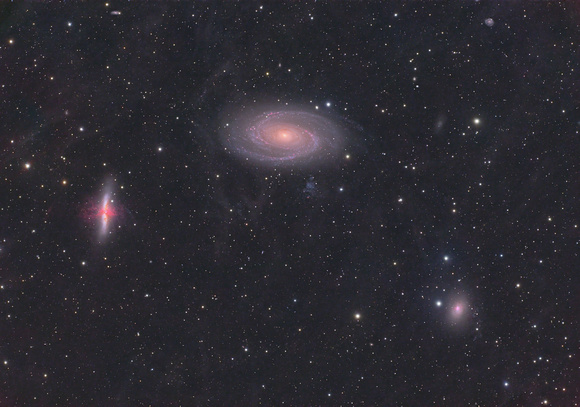Bode's Neighbourhood with Dust and Hydrogen
Bode’s Area in LHaRGB
Askar 151phq; AP Mach2 GTO
ASI6200MM, - Baader 6.5nm NB CMOS opt. filters
H: (79 x 550s 61Bin 1, Gain 200)
R,G,B: (79,76,75 x 120s, Bin 1, Gain 100)
L: (112x120s, Bin 1, Gain 100)
Total integration time = 23.4 hrs (Mar30, Apr 5, 21)
This was my little project to capture Bode’s Galaxy (M81) , the Cigar Galaxy (M82), other area galaxies complete with Ha emissions, and the IFN/dust so that all would be visible in a balanced manner.
Bodes Galaxy is a large, grand design spiral, with many star forming (Ha emitting) regions. At 96,000 ly diameter and 12 million lys distant it is archetypal and beautifully symmetric in appearance. Blue young star dominate in the outer arms along with strong Ha emitting regions indicating continued star formation. A very large black hole resides at the centre surrounded by yellow to red older stars. The galactic dust and molecular clouds appear brown/red as they are sheared into thinner filaments as the circle in towards the galactic centre.
The Cigar galaxy, contrast quite starkly from its larger neighbour. It may also have been a spiral form at one time, but it has been greatly disturbed by tidal / gravity effects likely due to an close encounter with M81. It appears as if the molecular material has be pulled out of the galactic plane and is seen as a red “moustache” of Ha signal. Free from the shearing caused by the spiral pattern, the molecular material has be able to condense more easily and is currently causing rapid star formation, and the Cigar galaxy is now classified as a “Starburst”. The stars in the galactic plane appear whiter and brighter (younger), and some red/brown dust still remains near the core.
The third largest galaxy (NGC3077) is smaller still, and also appears to be a Starburst galaxy from its strong Ha signal, and irregular appearance.
In addition, there are many background galaxies of various shapes, brightnesses, and sizes that are worth hunting for.
The dusty appearance of the image background is actually IFN or interstellar material associated with our Milky Way rather than more distant galaxy. It represents material just outside the Milky Way, and reflects the light from our galactic stars back down to us.
I took my time creating this image in order that the galaxies did not dominate the IFN, nor vice versa. In addition I focused in on detail, including a drizzle integration down to 0.5”/px. I think it is worth taking a zoomed in view to better see the detail. In the end it was a trade-off between showing the IFN more clearly, and blowing out the galaxies with brightness.


